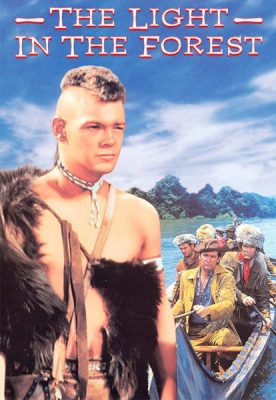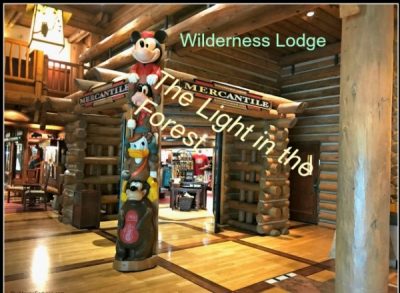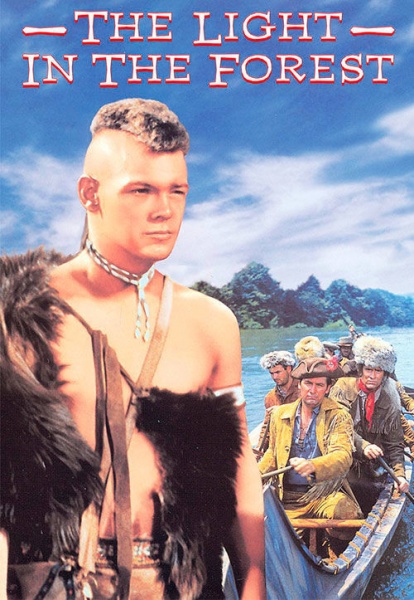
Based on Conrad Richter’s 1953 novel of the same name and on actual events involving European settlers and Native Americans in the mid-eighteenth-century Pennsylvania backcountry, Disney’s The Light in the Forest was theatrically released on August 8, 1958. The live action drama is ninety-three minutes in length.
Plot Summary
In late-1764, British forces under the command of Colonel Henry Bouquet (Stephen Bekassy) reach a deal with the Delaware Indians, the British promising not to encroach further onto Delaware lands if the Indians agree to return white captives to their families. The conciliatory Chief Cuyloga (Joseph Calleia) assents to the offer, and among the exchanged is Johnny Butler (James MacArthur), a teenager raised by Cuyloga as “True Son.” Far from being happy about his return to white society in the small Pennsylvania town of Paxton, however, Johnny feels betrayed and is initially more intent on playing dead and escaping to regain Cuyloga’s favor than on attempting to resume life with his mother, Myra (Jessica Tandy), and father, Harry (Frank Ferguson). To make matters worse, Johnny’s uncle Wilse Owens (Wendell Corey) is an extreme Indian hater and refuses to afford Johnny time to re-assimilate into white society. Fortunately for the townspeople, the interpreter sent by Bouquet to accompany Johnny back home, Del Hardy (Fess Parker), and Owens’s teenage indentured servant, Shenandoe (Carol Lynley), show compassion for Johnny and gradually begin to convince the young man that not all white people are evil—there are bad and good people among both the European settlers and the Native Americans—and that he can live a happy life in Paxton. Can Johnny find his place in this confused world?
Based on a True Story: The Paxton Boys
Although most of the characters in The Light in the Forest are fictional, Colonel Henry Bouquet and the Reverend John Elder (John McIntire) were real people, and the town of Paxton was a real town with major significance to both Pennsylvania and world politics. To this end, in December 1763, angered over both the underrepresentation of western counties in the Pennsylvania assembly and a desire by Quaker leaders in Philadelphia to defend the Native Americans at the expense of frontier security, between fifty and sixty men from Paxton massacred a combined twenty Indians under protection at Conestoga and Lancaster. Moving towards Philadelphia with similar intentions in February 1764, a larger group was stopped at Germantown by Benjamin Franklin, and two of the expedition’s leaders were permitted to compose a pair of petitions, a “Declaration” and a “Remonstrance,” to be considered by the assembly. (1)
The Delaware (or Leni Lenape) Indians were infuriated with settler encroachment onto their lands, a problem that had persisted since the controversial Walking Purchase of 1737. British authorities attempted to alleviate this bitterness at the height of the French and Indian War through the Treaty of Easton (1758) and after said war’s conclusion through both the Proclamation Line of 1763 and the 1764 treaty shown in the film. The major upshot of the French and Indian War, the removal of French influence from the North American continent, rendered the British the sole European party to the last negotiation. (2)
Colonel Bouquet was among the most important figures in Pontiac’s Rebellion of 1763, leading British and Pennsylvania forces to a decisive victory against their Indian opponents at the Battle of Bushy Run in August. (3)
As shown in the film, John Elder was simultaneously loyal to his Presbyterian, Scots-Irish neighbors in Paxton and a moderating influence on the more extreme of these neighbors, who largely did not discriminate between “friendly” and “enemy” Indians. The reverend, in a January 20, 1764 letter to Governor John Penn, agreed with colonial officials that “the rash proceedings of a few inconsiderate persons are likely to be attended with fatal consequences,”—the reverend had previously attempted, unsuccessfully, to stop the respective marches on Conestoga and Lancaster (4)—but Elder proceeded to complain about what he perceived as the Quakers’ and Moravians’ greater concern for the Indians than for their white neighbors. On this point, Elder explained, “The indulgence shown to savages gives a general disgust. It is thought hard that any such under the title of friends, but unjustly—as it is commonly thought—should be so much caressed and such numbers of them taken under the protection of the Province, and plentifully supplied at its expense, as an additional weight to the heavy burden it already groans under; while many frontier families, his Majesty’s loyal and faithful subjects, are driven from house and home, reduced to poverty and want, and little provision made for them.” (5)
Also as shown in the film, Elder was in charge of a military unit—in the summer of 1763, during the Pontiac Rebellion, Pennsylvania’s Deputy Governor, James Hamilton, afforded Elder command of two companies of fifty men each for the protection of Lancaster County. Although Elder fought in no actual battles, his enthusiasm for his role earned him the moniker the “Fighting Parson.” (6)
Emotion
An inability to control anger often causes devastation. Indeed, hotheads of both European and Native American origin, namely Wilse Owens of the former group and Niskitoon (Dean Fredericks) of the latter group, perpetuate the fighting throughout the film, overwhelming the wishes of the good people on each side.
Unfortunately, human nature renders difficult Shenandoe’s advice to Johnny: forego violence by ignoring and/or avoiding one’s antagonists as much as possible, for “it’s hating on both sides that starts all the trouble” and “killing just leads to more killing.”
Action
Brief action segments are interspersed throughout the film. Along the way, Hardy struggles to restrain Johnny on their march from the peace summit to Fort Pitt; the Paxton men compete in target practice; Wilse Owens batters Johnny; Johnny finds himself caught in the middle of an attempted Indian ambush of a white party floating down the river; and Johnny and Owens engage in decisive boxing match.
Music
The Light in the Forest’s main tune, “The Light in the Forest,” is incorporated lyrically over the opening credits and again during the film’s closing scene, and it is performed instrumentally during the body of the movie. The number is well described by Shenandoe in a line immediately following a reprisal towards the middle of the film: “Oh, it’s lovely!”.
Conversely, a festive, jovial number, “Hielan Laddie,” is played by a Scots-Irish band at a dance towards the middle of the film, and fife-and-drum music augments the marching scenes. Such music is fittingly incorporated immediately following the opening credits, indicating a disruption in the peaceful forest setting from the marching British troops. The forest is beautiful, but nature’s serenity is not impenetrable.
Humor
Though not a comedy, The Light in the Forest contains some awkwardly amusing lines, mostly about personal hygiene, and humorous banter between Johnny and his Indian friend Half Arrow (Rafael Campos). The scene towards the end of the film where Johnny and Half Arrow steal a canoe is especially funny.
Relationship to Other Disney Films
The Light in the Forest was the last of six Disney films to feature Fess Parker, who was named a Disney Legend in 1991. Parker had previously appeared in Davy Crockett, King of the Wild Frontier (1955), The Great Locomotive Chase (1956), Davy Crockett and the River Pirates (1956), Westward Ho, the Wagons! (1956), and Old Yeller (1957) for the studio.
The Light in the Forest was the first of four Disney films to feature James MacArthur, preceding Third Man on the Mountain (1959), Kidnapped (1960), and Swiss Family Robinson (1960).
A boy is also caught between two figurative worlds in Tarzan (1999).
Native Americans were also prominently featured in Davy Crockett, King of the Wild Frontier, Davy Crockett and the River Pirates, Westward Ho, the Wagons!, Tonka (1958), Savage Sam (1963), Those Calloways (1965), Treasure of Matecumbe (1976), The Apple Dumpling Gang Rides Again (1979), and Pocahontas (1995).
Real events in United States history were also portrayed in Davy Crockett, King of the Wild Frontier, The Great Locomotive Chase, Westward Ho, the Wagons!, Johnny Tremain (1957), Tonka, and Pocahontas.
Preachers were also prominently featured in The Littlest Outlaw (1955), Pollyanna (1960), Hot Lead and Cold Feet (1978), The North Avenue Irregulars (1979), and The Hunchback of Notre Dame (1996).
Deer, seen throughout The Light in the Forest, were at the forefront of Bambi (1942).
In the Parks
“Forest-inspired” accommodations are offered at Walt Disney World’s “Wilderness Lodge” and “Fort Wilderness Resort and Campground”; Disneyland Resort’s “Grand Californian Hotel and Spa”; and Disneyland Resort Paris’s “Sequoia Lodge” and “Davy Crockett Ranch.”

George Washington, a key figure in the French and Indian War, is prominently featured in the “Hall of Presidents” show at Walt Disney World’s Magic Kingdom.
Native American art is currently on display at the “Creating Tradition: Innovation and Change in American Indian Art” exhibit in the American Adventure pavilion at Epcot.
Overall
Like many other Disney films of the 1950s, The Light in the Forest offers an interesting representation of real events from America’s past. History buffs will enjoy the content, and all Disney fans can check a Fess Parker film off their “to-watch” lists.
Notes
1) Brooke Hindle, “The March of the Paxton Boys,” William and Mary Quarterly, 3d ser., 3, no. 4 (October 1946): 461-486, passim; James E. Crowley, “The Paxton Disturbance and Ideas of Order in Pennsylvania Politics,” Pennsylvania History: A Journal of Mid-Atlantic Studies 37, no. 4 (October 1970): 317-39, passim.
2) Michael Goode, “A Failed Peace: The Friendly Association and the Pennsylvania Backcountry during the Seven Years’ War,” Pennsylvania Magazine of History and Biography 136, no. 4 (October 2012): 472-474; Matthew C. Ward, “The ‘Peaceable Kingdom’ Destroyed: The Seven Years’ War and the Transformation of the Pennsylvania Backcountry,” Pennsylvania History: A Journal of Mid-Atlantic Studies 74, no. 3 (Summer 2007): 247-79, pp. 267-68.
3) Hindle, “March of the Paxton Boys,” p. 465; Charles S. Grant, “Pontiac’s Rebellion and the British Troop Moves of 1763,” Mississippi Valley Historical Review 40, no. 1 (June 1953): 75-88, p. 81.
4) Hindle, “March of the Paxton Boys,” pp. 465-67.
5) Hubertis M. Cummings, “The Paxton Killings,” Journal of Presbyterian History (1962-1985) 44, no. 4 (1966): 219-43, p. 238.
6) Ibid., p. 230.
What do you think of The Light in the Forest? Let me know in the comments!
Sponsored Ad: Would you like to help support The Mouse For Less website in continuing their mission of being THE Disney vacation planning resource? You can do so by purchasing The Light in the Forest from our Affiliate Link through Amazon. Thanks so much for your support!
Did you like this article? Make sure to share it with your friends! Check below for easy ways to share!
Incoming search terms:
- https://www themouseforless com/blog_world/movie-review-the-light-in-the-forest/

